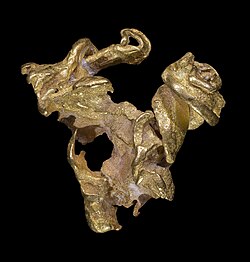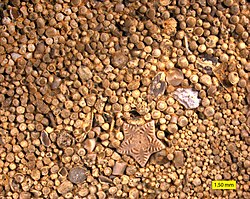Top Qs
Timeline
Chat
Perspective
Crystal habit
Mineralogical term for the visible shape of a mineral From Wikipedia, the free encyclopedia
Remove ads
In mineralogy, crystal habit is the characteristic external shape of an individual crystal or aggregate of crystals. The habit of a crystal is dependent on its crystallographic form and growth conditions, which generally creates irregularities due to limited space in the crystallizing medium (commonly in rocks).[1][2]

Remove ads
Crystal forms
Recognizing the habit can aid in mineral identification and description, as the crystal habit is an external representation of the internal ordered atomic arrangement.[1] Most natural crystals, however, do not display ideal habits and are commonly malformed. Hence, it is also important to describe the quality of the shape of a mineral specimen:
- Euhedral: a crystal that is completely bounded by its characteristic faces, well-formed. Synonymous terms: idiomorphic, automorphic;
- Subhedral: a crystal partially bounded by its characteristic faces and partially by irregular surfaces. Synonymous terms: hypidiomorphic, hypautomorphic;
- Anhedral: a crystal that lacks any of its characteristic faces, completely malformed. Synonymous terms: allotriomorphic, xenomorphic.
Remove ads
Altering factors

Factors influencing habit include: a combination of two or more crystal forms; trace impurities present during growth; crystal twinning and growth conditions (i.e., heat, pressure, space); and specific growth tendencies such as growth striations. Minerals belonging to the same crystal system do not necessarily exhibit the same habit. Some habits of a mineral are unique to its variety and locality: For example, while most sapphires form elongate barrel-shaped crystals, those found in Montana form stout tabular crystals. Ordinarily, the latter habit is seen only in ruby. Sapphire and ruby are both varieties of the same mineral: corundum.
Some minerals may replace other existing minerals while preserving the original's habit, i.e. pseudomorphous replacement. A classic example is tiger's eye quartz, crocidolite asbestos replaced by silica. While quartz typically forms prismatic (elongate, prism-like) crystals, in tiger's eye the original fibrous habit of crocidolite is preserved.
Remove ads
List of crystal habits
Summarize
Perspective
[3][better source needed][4][better source needed][5][better source needed][6]
Aggregate habits
Asymmetrical/Irregular habits
Symmetrical habits
Rounded/Spherical habits
Remove ads
See also
References
Bibliography
Wikiwand - on
Seamless Wikipedia browsing. On steroids.
Remove ads












































































